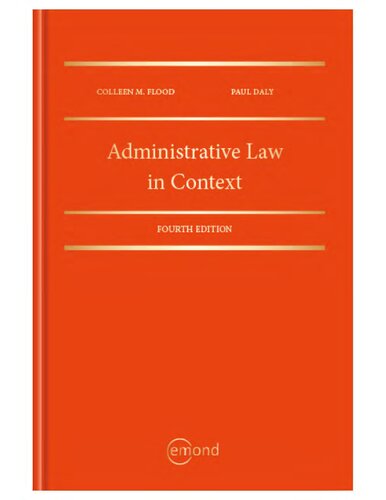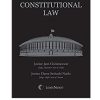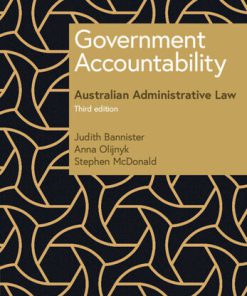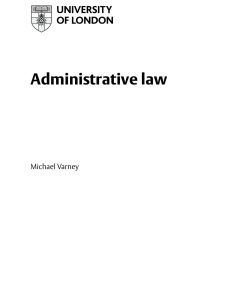Administrative Law in Context 4th Edition by Colleen Flood, Paul Daly 1774621185 9781774621189
$50.00 Original price was: $50.00.$25.00Current price is: $25.00.
Administrative Law in Context 4th Edition by Colleen Flood, Paul Daly – Ebook PDF Instant Download/Delivery: 1774621185, 9781774621189
Full dowload Administrative Law in Context 4th Edition after payment

Product details:
ISBN 10: 1774621185
ISBN 13: 9781774621189
Author: Colleen M. Flood, Paul Daly
Administrative Law in Context, 4th Edition examines the latest developments in the field of administrative law, relating to the important and contemporary contexts that shape legal ideas. This authoritative casebook provides a collaborative analysis of key principles and seminal cases by leveraging the voices of Canada’s leading scholars and practitioners. The fourth edition includes a practical and in-depth analysis of the Supreme Court of Canada’s 2019 Vavilov trilogy. Bell, NFL, and Vavilov’s seminal decisions generated fundamental changes to the appellate standards of review. This edition also includes updated chapter questions, discussions, commentary, and practice tips. This text employs an experiential teaching approach to the Canadian doctrine of administrative law, combining theory and applied learning to provide a text that students can take with them, from the classroom to the courtroom.
Administrative Law in Context 4th Table of contents:
Chapter One A Map for the Complex World of Administrative Decision-Making and Law
I. Introduction
A. A Brief Primer on the Canadian State
Part 1: The Origins of Administrative Law
II. The Beginnings of Administrative Law
III. The Constitution
IV. The Expansion of Formal Post-Colonial Government
A. The Early Years: 1850-1913
B. The First World War and the Growth of Economic Controls
C. The Inter-War Period
D. The Second World War and Its Aftermath
E. A Closer Look at the Reasons for the Expansion of Administrative Decision-Making
V. Conflicts and Tensions in Administrative Law
VI. From a Focus on Remedies to a Focus on Review
VII. Section 96 and the Courts’ Constitutional Right to Review Administrative Decisions
Part 2: An Introduction to Modern Administrative Law
VIII. Where to Start?
IX. Review for Procedural Fairness
A. Threshold Question
B. The Content of Procedural Fairness
C. Bias, Independence, and Institutional Decision-Making
X. Substantive Review: The Standard of Review and Application
A. A Brief History of Substantive Review
B. The Big Bang of Vavilov
XI. Conclusion
Suggested Additional Readings
PART I KEY THEMES AND CONCEPTS
Chapter Two What People Want, What They Get, and the Administrative State
I. Introduction
II. Remedial Options at the Tribunal Stage
A. Statutory Authority
B. What Makes Administrative Tribunals Unique
C. Systemic Remedies at the Tribunal Level
III. Enforcing Tribunal Orders Against Parties
A. The Tribunal Seeks to Enforce Its Order
B. A Party Seeks to Enforce a Tribunal’s Order
C. Criminal Prosecution
IV. Challenging Administrative Action Without Going to Court
A. Internal Tribunal Mechanisms
B. External Non-Court Mechanisms
V. Going to Court
A. Statutory Rights of Appeal to the Courts
1. Does the Tribunal’s Enabling Statute Provide for a Right of Appeal?
2. What Is the Scope of Available Appeal?
3. What Is the Standard of Review That a Court Should Apply on a Statutory Appeal?
4. Is an Appeal Available as of Right, or Is Leave Required? If Leave Is Required, Who May Grant It?
5. Is a Stay of Proceedings Automatic, or Do You Have to Apply for It?
B. Using the Courts: Judicial Review
1. Discretionary Bases for Refusing a Remedy
2. Is Judicial Review Available? Threshold Eligibility Questions
3. Remedies on Judicial Review
C. Private Law Remedies
VI. Conclusion
Suggested Additional Readings
Chapter Three Everything You Always Wanted to Know About the Rule of Law but Were Afraid to Ask in C
I. The Rule of Law Legally, Practically, and Theoretically
A. Instituting the Rule of Law
B. Arbitrariness and the Rule of Law
C. Politics and the Rule of Law
D. Founding the Administrative Rule of Law
II. Deference as Respect: The Canadian Model of Administrative Law
A. The Principle of Deference (as Respect)
B. Deference as Respect in Action
1. The Life (and Death?) of the Privative Clause as a Legislative Signal for Deference
2. Interpreting Reasonableness
C. Reasons and the Culture of Justification
D. Judicial Discretion and Deference
III. Democracy, Deference, and the Rule of Law
IV. Other Routes to Accountability in the Administrative State
V. Conclusion: A Democratic Rule of Law in the Administrative State
Suggested Additional Readings
Chapter Four Delegation and Consultation: How the Administrative State Functions and the Importance
I. Introduction
II. Why Do Legislatures Delegate to Administrative Decision-Makers?
III. The Risks of Delegation
IV. Allocating Power and Controlling Risks
A. How Much Power Should Be Delegated?
B. To Whom Should the Power Be Given?
C. How Should the Power Be Exercised?
1. Why Consult?
2. Legislating Process
3. Executive Action
4. Judicial Review of Process
5. The Duty to Consult and Accommodate in Rule-Making
6. Consultation and Interest Group Power
D. How Should We Monitor How the Powers Are Being Used?
1. Legislative and Executive Oversight
2. Judicial Review of Substance
V. The Search for a Balance
Chapter Five Realizing Aboriginal Administrative Law
I. Introduction
II. Administrative Law as Arbiter Between Indigenous Peoples and the Crown
A. The Relationships Between the Administrative State and Indigenous Peoples
B. Challenges Arising from the Relationships
III. Recognizing and Implementing Aboriginal Rights
A. Determining Aboriginal Rights: Negotiations Policies and Tribunals
B. The Duty to Consult and Accommodate: How Much Further Down the Path to Reconciliation?
IV. Administrative Law in Indigenous Governance
A. The Context of Self-Government and Review of Indigenous Governments and Decision-Makers
B. Beyond (or Before) Judicial Review: Recognizing the Authority of Indigenous Law
V. Conclusion
PART II PROCEDURAL FAIRNESS
Chapter Six Fair Processes for Just Outcomes: The Principles and Practices of Procedural Fairness
I. Introduction
II. The Principles of Fairness
A. The Inherent Value of Fairness
1. Extending the Reach of Procedural Obligations
2. The Legal Consequences of Unfairness
B. The Rule of Law and Access to Justice
C. Enfranchisement and Flexibility
III. The Practices of Procedural Fairness
A. Procedural Obligations Arising from Statute, Regulations, Rules, and Guidelines
1. Enabling and Internal Instruments
2. General Procedural Codes
B. Procedural Obligations Arising from the Constitution
C. Procedural Obligations Arising from the Common Law
1. Step 1: Is the Duty of Fairness Triggered?
2. Step 2: What Does the Duty Entail?
IV. Challenging Unfairness
V. Conclusion
Chapter Seven A Charter Twist on Procedural Fairness
I. Introduction
II. Procedural Fairness and the Principles of Fundamental Justice
A. Oral Hearings and the Scope of Section 7
B. Incorporation of the Common Law Framework Under Section 7
C. The Duty to Disclose and the Right to Reply
D. The Duty to Give Reasons
E. The Right to State-Funded Legal Counsel
F. Independence of Decision-Maker
G. Undue Delay
H. Ex Parte, in Camera Hearings
III. Conclusion
Suggested Additional Readings
Chapter Eight The Duty of the Administrative State to Consult Indigenous Peoples
I. Introduction
II. Who Must Consult and When
III. The Content of the Duty to Consult
IV. The Roles of Administrative Agencies
V. Challenging Inadequate Consultation
VI. Conclusion
Chapter Nine The Architecture of Fairness: Independence, Impartiality, and Bias
I. Introduction
II. Sources of the Guarantee of an Independent and Impartial Tribunal
III. What Is “Tribunal Independence,” and Why Is It Important?
IV. The Development of the Law of Tribunal Independence in Canada
A. The First Wave of Tribunal Independence Jurisprudence: Laying the Groundwork
1. The Theory of Judicial Independence
2. From Judicial Independence to Tribunal Independence
B. The Second Wave: Parliamentary Supremacy Versus Warding Off Interference
1. Ocean Port
2. Keen v Canada
C. Third Wave—Reasserting the Push for Independence: Unwritten Constitutional Principles, Tribunal
D. Can Independence Be Strengthened Through Policy Reform? Comparing Institutional Arrangements Acro
1. Institutional Arrangements
2. Conclusion
V. Reasonable Apprehension of Bias
A. The Rule Against Bias
B. The Reasonable Apprehension of Bias Test
1. Perceptions of Individual Bias
2. Public Advocacy, Adjudicator Diversity, and Bias
3. Social Media and Disqualifying Bias
4. Statistical Analysis of Decision-Maker Outcomes
5. Perceptions of Institutional Bias
6. Self-Represented Litigants and Reasonable Apprehension of Bias
VI. Conclusion
Suggested Additional Readings
Chapter Ten Spanning the Constitutional Divide Between the Judiciary and the Executive: The Ill-Fate
I. Introduction
II. The Flexible Independence of Administrative Tribunals
A. Judicial Independence
B. Independence of Administrative Tribunals
III. The Independence of Administrative Justice in Quebec
A. Section 23 of the Quebec Charter of Human Rights and Freedoms
B. The Status of Independent Decision-Makers in Quebec
IV. Conclusion
PART III SUBSTANTIVE REVIEW
Chapter Eleven A Short History of Standard of Review
I. Introduction
II. The Pre-History
III. CUPE v New Brunswick Liquor Corporation
IV. From CUPE to Pushpanathan
V. Dunsmuir: And Then There Were Two (Again)
A. The Correctness Exceptions
B. What Happened to Expertise?
C. Inconsistency and Correctness
VI. Doing Deference: Looking for Clues
Suggested Additional Readings
Chapter Twelve Big Bang Theory: Vavilov’s New Framework for Substantive Review
I. Introduction
II. Applying the Reasonableness Standard
A. Methodology
B. Deference
1. Justification and Demonstrated Expertise
2. Responsiveness
3. Contemporaneity
C. Specific Legal and Factual Constraints
1. Statutory Interpretation
2. Governing Statutory Scheme
3. Consistency
4. Harsh Consequences
III. Selecting the Standard of Review
A. Institutional Design
1. Statutory Appeals
2. Legislated Standards of Review
B. The Rule of Law
1. Constitutional Questions
2. Overlapping Jurisdiction
3. Questions of Central Importance to the Legal System
C. Further Correctness Categories?
IV. Remedies
V. Conclusion
Suggested Additional Readings
Chapter Thirteen One of These Things Is Not Like the Other: Vavilov and Municipal Decision-Making
I. Introduction
II. Pre-Vavilov Deference to Municipalities
III. Determination of the Standard of Review
A. Jurisdictional Questions Do Not Attract Correctness Review (Except When They Do)
B. Letter of the Law: Strict Adherence to Statute
IV. Reasonableness Review and Municipalities
A. Absence of Reasons Is Not Fatal in Municipal Decisions
B. Reasons Are Still Required in Many Situations
V. Conclusion: Future Implications for the Substantive Review of Municipal Decisions
Chapter Fourteen International Human Rights Norms and the Substantive Review of Administrative Decis
I. Introduction
II. A Short Introduction to International Human Rights Law
III. Rules of Reception of International Law
A. Reception of Customary International Human Rights Law
B. Reception of Conventional International Human Rights Law
C. International Norms and Statutory Interpretation
1. The Use of International Law to Establish Legislative Intent as a Matter of Fact
2. The Use of International Law to Establish the Legislature’s Presumed Intent
IV. International Human Rights Norms and the Substantive Review of Administrative Decision-Making
A. International Human Rights Norms, Statutory Interpretation, and Substantive Review
1. International Human Rights Norms and the Applicable Standard of Review
2. International Human Rights Norms and Reasonableness Review
B. International Human Rights Norms, Charter Interpretation, and Substantive Review
1. International Human Rights Norms and Charter Interpretation
2. International Human Rights and the Substantive Review of Decisions Engaging Charter Protections
V. Conclusion
Suggested Additional Readings
Chapter Fifteen The Charter and Administrative Law: Substantive Review
I. Introduction
A. From Slaight to Doré and Beyond—A Brief History
B. Doré
C. Do the Different Approaches Produce Different Results?
D. The Role of Charter Values Post Doré
E. Conclusion
II. Agency Jurisdiction over the Charter
A. The Old Trilogy and “Jurisdiction over the Whole Matter”
B. Vindication of the Dissent in Cooper?
C. Remedies Under Section 24(1)
III. Conclusion
Suggested Additional Readings
PART IV FORUMS
Chapter Sixteen Fairness in Context: Achieving Fairness Through Access to Administrative Justice
I. Introduction
II. Fairness by Design: Human-Centred Design and Access to Administrative Justice
III. Access to Administrative Justice: The Tribunal
A. Standing
B. Hearings
IV. Access to Administrative Justice: Information and Knowledge
A. Guidelines
B. Simplification
C. Language
D. Prior Decisions
E. People
V. Access to Resources Needed to Navigate the Tribunal System
A. Legal Representation
B. Law, Technology, and Access
C. Fees and Costs
1. Fees
2. Costs
D. Budget and Staffing
VI. Conclusion
Chapter Seventeen Habeas Corpus Unbound
I. Introduction
II. Prisons: Plenty of Rules, Not Much Rule of Law
III. A Too-Brief History of Habeas Corpus
IV. Habeas Corpus: Doctrine
A. Preliminaries
B. The Test
1. Deprivation of Liberty
2. Legitimate Ground
3. Legality (Onus on Authorities)
C. Remedies and Rule of Law Redux
V. Conclusion
Chapter Eighteen Much Ado about Quite a Bit: Administrative Agencies
I. Introduction
II. Administrative Agencies and Front-Line Decisions
A. First-Instance Final Decisions
B. Aggregated Decision-Making
C. Operational Discretion
D. Assistive Policies and Technologies
III. Administrative Law Within Administrative Agencies
A. Fair Processes
1. Notice, Disclosure
2. Hearing
3. Reasons
B. Open-Minded Decision-Makers
C. Acceptable Outcomes
1. Quality Assurance Measures
2. Constraints Among Polarized Workers
3. Reason-Giving Practices
IV. Conclusion
Suggested Additional Readings
Chapter Nineteen At the Core of Things: Section 96 of the Constitution Act, 1867 and Administrative
I. Introduction
II. Who Are the Superior Courts, and What Do They Do?
A. Section 96 and Its Purposes
B. Inherent Jurisdiction of the Superior Courts
C. Crevier and the Constitutional Status of Judicial Review by the Superior Courts
D. Where Do the Federal Courts of Canada Fit?
III. What Does Section 96 Mean for Administrative Law?
A. A Constitutional Limit on Transfer of Powers to Administrative Tribunals
B. Preserving the Core Jurisdiction of Superior Courts
IV. Section 96 Challenges Alleging Denial of Access to Justice
A. Access to Justice and Small Claims Jurisdiction: The Court of Quebec Reference
B. Access to Justice and Alternative Dispute Resolution: The Civil Resolution Tribunal in BC
V. Conclusion: Access to Justice and Section 96
Chapter Twenty Crown Liability for Negligent Administrative Action
I. Introduction
II. Liability of Public Authorities—Basic Principles
A. The Anns Test
1. The First Stage—Foreseeability and Proximity
2. The Second Stage—Policy/Operational
B. A Role for Administrative Law
1. It Is Necessary to Distinguish Between the Crown’s Public and Private Activities
2. Can a Legal Exercise of Authority Be a Tort or Fault?
3. What About Illegal Government Action?
4. A Fresh Approach?
III. Conclusion
Chapter Twenty-One 3Ps: A Public/Private Primer
I. The Two Faces of the Common Law
A. Public and Private in the Common Law
B. The Basic Structure of Public and Private Legal Relationships
C. Another Brick in the Wall: The New Public/Private Test
II. P1: Private Actors and Voluntary Associations
III. P2: Privatization and Contracting Out
IV. P3: Remedies and Public Authority Liability in Tort Law
V. Conclusion: Back to the Future or Back to the Past?
Suggested Additional Readings
Appendix Table of Selected Federal and Provincial Administrative Boards and Tribunals
Index
Back Cover
People also search for Administrative Law in Context 4th :
what are administrative acts
what is administrative action in administrative law
administrative law is created
context in law
Tags:
Colleen Flood,Paul Daly,Administrative Law
You may also like…
Jurisprudence & Law - Constitutional Law
Administrative Law in Action : Immigration Administration 1st Edition Robert Thomas
Jurisprudence & Law - Constitutional Law
Administrative Law and Judicial Deference 1st Edition Matthew Lewans
Uncategorized
Education Studies & Teaching - Individual Colleges & Universities
Administrative Law LA2008- Module Guide (University of London) 2022nd Edition M. Varney
Jurisprudence & Law - Constitutional Law
Jurisprudence & Law
Contemporary French Administrative Law 1st Edition John Bell
Jurisprudence & Law - Constitutional Law
Constitutional and Administrative Law 2nd Edition Roger Masterman











